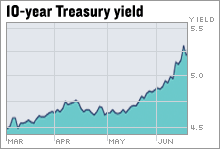Bonds: The worst may be overAfter a selloff sent the 10-year Treasury yield to a 5-year high, some experts think rates have peaked for now. Or have they?NEW YORK (CNNMoney.com) -- The recent spike in Treasury bond yields is expected to set the tone for the financial markets for the foreseeable future. So the big debate on Wall Street now is whether bond rates will head even higher or dip back below 5 percent. The price of the benchmark U.S. 10-year Treasury note has fallen in recent months, sending yields, which move in the opposite direction of prices, from a yearly low of 4.49 percent in early March to 5.3 percent on Tuesday, the highest level in five years.
The selloff came as many big bond investors became convinced that interest rates were rising worldwide, and that the Federal Reserve was now all but certain to hold rates steady the rest of the year, rather than cutting them as some had hoped. There were also worries about selling by big investors, like China, overseas. The resulting rise in yields spooked many on Wall Street since bond market rates help set rates on mortgages and many other consumer and corporate loans. Indeed, the rate on the 30-year mortgage posted its biggest jump in four years this week. So the fear is that higher yields will further hurt the already reeling housing market, and slow consumer spending, which accounts for more than two-thirds of the economy. In addition, corporate borrowing, which has fueled much of the recent merger activity that's helped lift stocks this year, could also dry up. But bond yields have dipped back in recent days, with the 10-year yield at about 5.19 percent Friday. And a report about consumer prices in May released Friday morning showed that while inflation may not be dead, it is does not appear to be a pressing problem either. Some bond experts said yields may not head much higher in the near-term since typically, rising bond yields are associated with higher inflation and a very strong economy. With this in mind, while Fed rate cuts are probably off the table, the central bank most likely won't need to raise rates any time soon either. As a result, yields could begin to drift back towards 5 percent, and possibly below it, as more investors start to buy bonds again. "The recent sell-off created a strange situation where the market was betting on a rate hike later this year. But that's almost like betting that it will snow in New York next week," said Michael Cheah, a portfolio manager with AIG SunAmerica Asset Management who oversees about $2 billion in bond assets. Cheah said he was not overly worried by the selloff, noting it was mostly for technical reasons, not because of real fears about inflation or the economy. He explained that since there has been such a glut of corporate debt at attractive prices, many bond managers wound up selling Treasury securities in order to buy corporate bonds. But demand might swing back to Treasuries after Friday's inflation report. "The May inflation number knocked some sense into people. Why would we even talk about the Fed raising rates given how benign inflation is? This should encourage real money to buy Treasury bonds," Cheah said, adding he's confident the yield on the 10-year Treasury will soon dip back below 5 percent. Michael Strauss, chief economist with Commonfund, an institutional investment firm based in Wilton, Conn. that manages about $40 billion in assets, agreed that some bond investors appear to have made an incorrect bet about how bad inflation would be. He added that the bond sell-off was also intensified by the recent rise in mortgage rates. This, Strauss explained, caused investors in mortgage-backed securities to sell Treasuries to take some money off the table and thus help offset the risk of a decline in home refinancing activity, which could hurt the value of mortgage bonds. "Some of the sell-off in the bond market may have been related to mortgage portfolios hedging. And some may have been sparked by inflation concerns that have not been realized," said Strauss, who thinks the worst of the bond slump may be over and that long-term rates will probably settle into a range of about 4.75 percent to 5.25 percent. Steve Van Order, the chief fixed income strategist with Calvert Funds in Bethesda, Md., also said he thinks the rise in bond yields is not a major concern for now since it was fairly orderly. He believes the market simply needed to play catch-up with the Fed since rates were stubbornly low despite the Fed's 17 straight short-term rate hikes in 2005 and 2006, as well the recent rate hikes from foreign central banks. "We have all this news about central banks around the world tightening and our interest rates have to go up with them. Plus, there is a recognition that the Fed isn't going to cut rates any time soon. It could remain on hold for a long time, longer than many think, and the bond market had to reprice to that reality," said Van Order, who oversees $15 billion in fixed- income assets. Van Order's not sure if yields will head back below 5 percent soon. But he does believe bond yields have probably stabilized for now - a good thing since the yield curve, which is the difference between short-term rates and long-term rates, now paints a healthier picture about the economy. Before the recent rise in yields, longer-term bond yields were much lower than the 5.25 percent federal funds rate, an overnight bank lending rate for which the Fed sets the target. When short-term rates are higher than long-term rates, the yield curve is said to be inverted and that phenomenon has often been a predictor of a recession. "Some of the good news about the runup in yields is that we now have a Treasury yield curve that has steepened and has been restored to something that looks a bit better for the economy," Van Order said. But John Canavan, an analyst with Stone & McCarthy, a Princeton, N.J.-based fixed income and economic research firm, thinks the U.S. economy is not out of the woods yet. "The housing market still poses a significant risk. Should the housing market continue to slow down, there is a risk of a greater spillover in consumer spending and the broader economy," he said. As such, Canavan said that yields could fall below 5 percent again later in the year. But for the time being, he expects long-term yields to remain in a range of about 5.1 percent to 5.3 percent since the global economy still appears to remain in good shape. |
|


